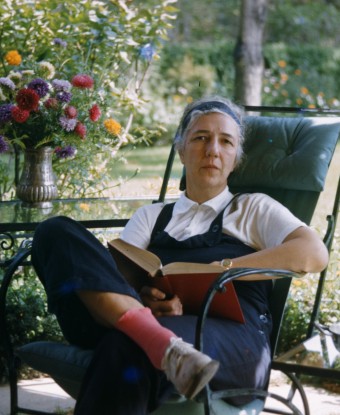Last updated: February 13, 2025
Person
Marion Dickerman

NPS/Cook-Dickerman Collection
Marion Dickerman (1890-1983) was born April 11, 1890, in Westfield, New York. She studied for two years at Wellesley College before transferring to Syracuse University, where she was an avid supporter of woman's suffrage and campaigned for protective labor legislation for women, the abolishment of child labor, and world peace. Marion received her bachelor of arts in 1911 and a graduate degree in education in 1912. After a brief teaching assignment in Canisteo, New York, in 1913 Marion moved to Fulton, New York, where she taught American history and became reacquainted with Syracuse classmate Nancy Cook, who taught arts and handicrafts at Fulton High School. The two women would become lifelong partners, living together almost their entire adult lives, sharing a life dedicated to politics, education, and progressive reform.
When World War I erupted, Marion and Nancy threw themselves into war-related activities, especially working with the Red Cross and for the Liberty Loan drive. In early spring 1918, she and Nancy traveled to London to work for the women-staffed Endell Street Military Hospital. When they returned home the following August, Marion was amazed to learn that the Joint Legislative Committee and progressive Democratic leadership in Fulton had selected her to oppose Thaddeus Sweet, Republican speaker of the New York State Assembly. Marion had no chance of winning the election; however, with Nancy as her manager, she siphoned away enough votes to prevent Sweet from becoming the Republican gubernatorial nominee. In 1921, Marion accepted a position as dean at the New Jersey State College in Trenton and spent the summer teaching English at Bryn Mawr's Summer School for Women Workers. Unhappy, she looked for a job she loved closer to New York City, where Nancy had moved to accept a position with the State Democratic Committee. By summer 1922, Marion had moved to New York City and joined the faculty of the Todhunter School.
Marion met Eleanor Roosevelt in June 1922 when Marion accompanied Nancy, then the executive secretary of the Women's Division of the State Democratic Committee, to Hyde Park for a weekend visit. The three women, sharing political ideas and tremendous energy, became steadfast friends, working together for the Women's Trade Union League, the League of Women Voters, and the Democratic National Committee. As Eleanor Roosevelt recalled in her autobiography, "Miss Cook and Miss Dickerman and I . . . had been from the first drawn together through the work which we were doing together. This is, I think, one of the most satisfactory ways of making and keeping friends." By 1927, in addition to their political work, the three women would share the Val-Kill property, Val-Kill Industries, and the Todhunter School. Their friendship would last more than fifteen years.
Marion and Nancy prided themselves as diplomatic workers in the sometimes difficult relationship of Eleanor and Franklin. Eventually Marion’s allegiance appeared to Eleanor to favor FDR. By 1932, Eleanor had other new friends like Lorena Hickok who disliked Marion, and Marion, elated by FDR's victory, could not appreciate Eleanor’s great anxiety over moving into the White House. By late 1933, as Eleanor’s responsibilities introduced her to a wider world and her interests and friendships expanded, she had less time to spend with Marion and Nancy. By 1936, when Val-Kill Industries dissolved, Eleanor relinquished her share of the cottage at Val-Kill in exchange for full and clear ownership of the former Val-Kill Industries factory building which she remodeled as a private residence where she could entertain without imposing on or involving Marion and Nancy. When Marion sought Eleanor’s active help in securing a loan from Bernard Baruch to expand the Todhunter School, Eleanor, who worried about the wisdom of expanding the school when the economy was not strong, refused to invest in the expansion and was relieved when the deal fell through.
In the summer of 1938, FDR named Marion to the President's Commission to Study Industrial Relations in Great Britain and Sweden. While she was abroad, Eleanor and Nancy had a serious disagreement. By October 1938, their friendship was in decline. Historian Blanche Cook argues that Eleanor resented the inference that Marion and Nancy had helped create her. Although Marion remained close to FDR, her future involvement with Eleanor gradually faded to only Christmas and birthday gifts. The legal disentanglement of their financial relationship in the Val-Kill property, Val-Kill Industries and the Todhunter School would take most of 1939. The emotional toll was just as great.
Maroin continued to be active in Democratic politics and, as an alternate delegate to the 1940 Democratic convention, helped secure an isolationist plank in the foreign policy platform sought by FDR. After FDR's death in 1945, Marion and Nancy moved to New Canaan, Connecticut, where Marion directed educational programing for the Marine Historical Association, which later became Mystic Seaport, the Museum of America and the Sea. She died May 16, 1983 in Kennett Square, Pennsylvania.
